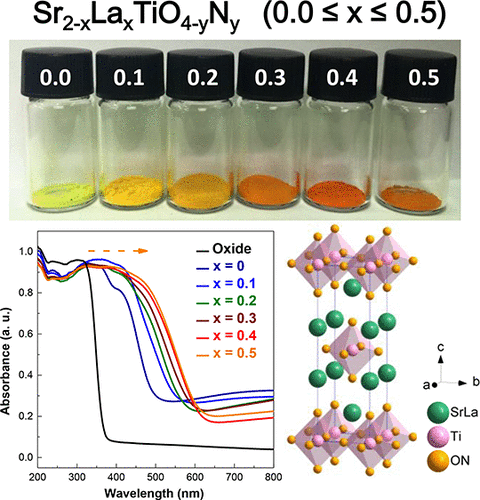当前位置:
X-MOL 学术
›
ACS Catal.
›
论文详情
Our official English website, www.x-mol.net, welcomes your
feedback! (Note: you will need to create a separate account there.)
Activating Layered Perovskite Compound Sr2TiO4 via La/N Codoping for Visible Light Photocatalytic Water Splitting
ACS Catalysis ( IF 11.3 ) Pub Date : 2018-03-09 00:00:00 , DOI: 10.1021/acscatal.8b00369 Xiaoqin Sun 1 , Yongli Mi 1, 2 , Feng Jiao 3 , Xiaoxiang Xu 1
ACS Catalysis ( IF 11.3 ) Pub Date : 2018-03-09 00:00:00 , DOI: 10.1021/acscatal.8b00369 Xiaoqin Sun 1 , Yongli Mi 1, 2 , Feng Jiao 3 , Xiaoxiang Xu 1
Affiliation

|
Solar water splitting into H2 and O2 upon a particulate photocatalyst relies on significant advances in material engineering where a number of important properties such as optical absorption, charge transportation, defect level, etc. can be manipulated. In this work, we have gained control over these properties for the wide band gap semiconductor Sr2TiO4 and successfully actualized water splitting under visible light illumination. This has been realized by codoping La/N into the laminated perovskite structure of Sr2TiO4. Strong visible light absorption as far as 650 nm can be tailored by varying the La/N content in Sr2–xLaxTiO4–yNy (0 ≤ x ≤ 0.5). Optimal photocatalytic H2 and O2 production has been achieved at x = 0.2, 0.3 and outweighs that of a number of typical perovskite oxynitrides. These activities are a function of several important parameters for photogenerated charges (e.g., concentration, mobility, and lifetime) which are all linked to La/N codoping levels. More strikingly, overall water splitting has been achieved at x = 0.2 with Rh/Cr2O3 as a cocatalyst. Defects such as Ti3+ species play a negative role in the photocatalytic activity, as they strongly promote charge recombination and shorten the electron lifetime. Theoretical calculations reveal the crucial role of N in uplifting the valence band maximum of Sr2TiO4 by hybridization with O 2p orbitals. La, therefore, balances the charge discrepancies induced during N/O replacements which would otherwise be unfeasible for substantial doping. Our calculations also suggest that Sr2TiO4 has a 2D charge transportation character which is extremely useful for charge separations.
中文翻译:

通过La / N共掺杂活化层状钙钛矿化合物Sr 2 TiO 4,用于可见光光催化水分解
在颗粒状光催化剂上分解成H 2和O 2的太阳能水依赖于材料工程学的重大进步,其中可以控制许多重要的特性,例如光吸收,电荷传输,缺陷水平等。在这项工作中,我们已经控制了宽带隙半导体Sr 2 TiO 4的这些特性,并成功实现了在可见光照射下的水分解。这是通过将La / N共掺杂到Sr 2 TiO 4的钙钛矿结构中来实现的。通过改变Sr 2– x La x中的La / N含量,可以定制高达650 nm的强大可见光吸收的TiO 4- ÿ Ñ ý(0≤ X ≤0.5)。在x = 0.2、0.3时达到了最佳的光催化H 2和O 2产量,并且超过了许多典型的钙钛矿型氧氮化物的产量。这些活性是光生电荷的几个重要参数(例如浓度,迁移率和寿命)的函数,这些参数都与La / N共掺杂水平有关。更为显着的是,使用Rh / Cr 2 O 3作为助催化剂,在x = 0.2时实现了总的水分解。Ti 3+等缺陷物种在光催化活性中起负作用,因为它们强烈促进电荷复合并缩短电子寿命。理论计算揭示了氮在通过与O 2p轨道杂交来提高Sr 2 TiO 4的价带最大值中的关键作用。因此,La平衡了在N / O替换期间引起的电荷差异,否则电荷差异对于大量掺杂是不可行的。我们的计算还表明,Sr 2 TiO 4具有二维电荷传输特性,这对于电荷分离极为有用。
更新日期:2018-03-09
中文翻译:

通过La / N共掺杂活化层状钙钛矿化合物Sr 2 TiO 4,用于可见光光催化水分解
在颗粒状光催化剂上分解成H 2和O 2的太阳能水依赖于材料工程学的重大进步,其中可以控制许多重要的特性,例如光吸收,电荷传输,缺陷水平等。在这项工作中,我们已经控制了宽带隙半导体Sr 2 TiO 4的这些特性,并成功实现了在可见光照射下的水分解。这是通过将La / N共掺杂到Sr 2 TiO 4的钙钛矿结构中来实现的。通过改变Sr 2– x La x中的La / N含量,可以定制高达650 nm的强大可见光吸收的TiO 4- ÿ Ñ ý(0≤ X ≤0.5)。在x = 0.2、0.3时达到了最佳的光催化H 2和O 2产量,并且超过了许多典型的钙钛矿型氧氮化物的产量。这些活性是光生电荷的几个重要参数(例如浓度,迁移率和寿命)的函数,这些参数都与La / N共掺杂水平有关。更为显着的是,使用Rh / Cr 2 O 3作为助催化剂,在x = 0.2时实现了总的水分解。Ti 3+等缺陷物种在光催化活性中起负作用,因为它们强烈促进电荷复合并缩短电子寿命。理论计算揭示了氮在通过与O 2p轨道杂交来提高Sr 2 TiO 4的价带最大值中的关键作用。因此,La平衡了在N / O替换期间引起的电荷差异,否则电荷差异对于大量掺杂是不可行的。我们的计算还表明,Sr 2 TiO 4具有二维电荷传输特性,这对于电荷分离极为有用。











































 京公网安备 11010802027423号
京公网安备 11010802027423号